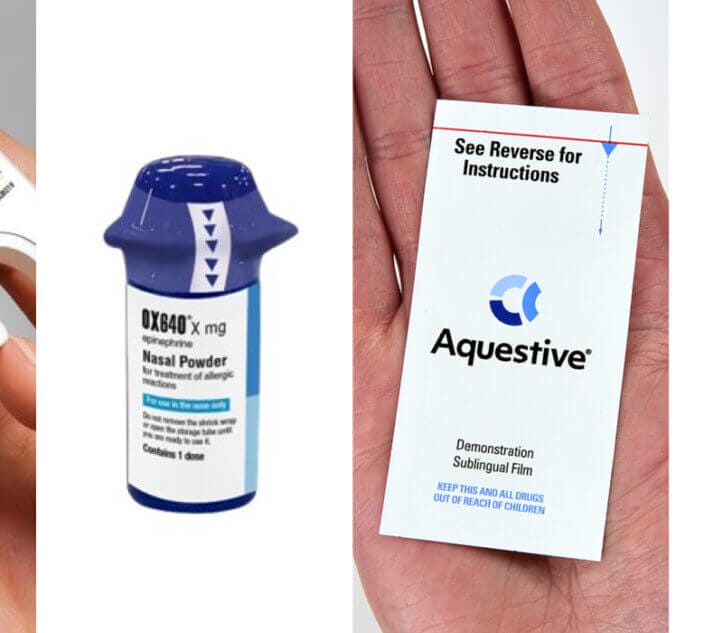
Tips: Using Asthma Inhalers
1. Using inhalers correctly ensures maximum benefit of the medication. To check if you are using your asthma inhaler correctly, demonstrate your technique in front of your doctor or asthma educator.
2. Stand up or sit up straight when you use any inhaler – this naturally expands the lungs.
3. Breathe all the way out before inhaling the medication, and hold your breath in for a count of 10 after inhaling a dose.
4. If you use an asthma inhaler only occasionally, check its expiry date to make sure the product is still usable.
5. In the situation that you need to use two puffs, inhale one puff at a time and separate each dose by 30 seconds.
6. When you need to administer a bronchodilator and an inhaled corticosteroid (ICS) at the same time, use the bronchodilator first and the ICS 1 minute later. The bronchodilator will open the airway allowing greater penetration of the ICS.
7. Keep your asthma inhalers in a cool, dry place. Powder inhalers are particularly susceptible to clogging.
Metered-Dose Inhalers (MDIs)
The metered-dose aerosol inhaler is the most common asthma inhaler in use. Examples of MDIs include Ventolin, authorized generic Flovent HFA and Asmanex. (Branded Flovent has been discontinued.)
The correct use of this asthma inhaler is important in order to ensure that the medication, which is traveling at almost 60 miles an hour, does not just hit the back of the throat.
The best way to use an MDI is with a spacer device, which minimizes the drug deposition in the mouth and throat by enhancing drug delivery deep into the lungs. If you’re using an MDI without a spacer, you need to co-ordinate pressing down on the cannister and inhaling the aerosolized medication so that those two actions occur at the same time.
Things to Remember
– Rinse your mouth after using your metered-dose inhaler to prevent thrush.
– The sleeve of the asthma inhaler can be removed and cleaned with soap and water when needed, but ensure to dry it thoroughly.
– The removable cap should be replaced after each use to keep dust and dirt from clogging the spray orifice.
– You will know that your MDI is empty when the spray stream is weak and insufficient amount of medication is released, or when the counter window approaches zero, but not by shaking the inhaler.
Dry Powder Asthma Inhalers
Some dry powder inhalers are in flat diskus devices, while others are in handheld inhalers. Diskus examples include Advair (for those over age 12) and the authorized generic Flovent diskus. Also commonly prescribed is the Ellipta dry powder inhaler, a metered device that’s a variant on the standard diskus shape.
When a diskus is opened, a mouthpiece and a lever appear. In most cases, pushing in the lever loads a dose and the medication is inhaled through the mouthpiece. If you need to inhale a second dose, the diskus has to be closed and re-opened to reposition the lever.
Handheld dry powder inhalers include the Pulmicort Flexhaler and the Asmanex Twisthaler. All require the ability to strongly breathe in the powder.
Turbuhalers
Turbuhalers are also dry powder devices that deliver medication when you breathe in. Examples of turbuhalers are Symbicort and Oxeze. To load a dose, turn the base right, then left and listen for a “click”. There is very little powder that is dispensed, so you may not feel the medication enter your airway. The counter window will tell you how many doses are left. When shaking the inhaler you are hearing a desiccant, a powder that keeps the inhaler dry. Replacing the cap is important because it prevents humidity and heat from clogging the inhaler.
Asthma Spacers
Also known as an aerochamber, a spacer is a device that helps optimize the use of a metered-dose inhaler (MDI). It is a clear, plastic tube with a receptacle that holds the MDI in one end and a mouthpiece with a one-way valve. Spacers make the use of an MDI easier and also allow the medication to penetrate deeper into the lungs and minimize its deposition in the mouth and throat. Studies show that an aerochamber delivers anywhere from 3 to 5 times the amount of the dose into the lungs when compared with an MDI alone.
Spacer Masks
Masks are usually necessary for infants, children and those who cannot seal their lips around the mouthpiece of a spacer. However, they provide a surface that attracts the medication, and can cause some of the dose to be deposited on the mask. Although using a spacer with a mask is far superior than using the MDI alone, the mask can be looked at as ‘training wheels’. It’s very useful when necessary, but removed when the patient’s ready.
Nebulizers
A nebulizer is a machine that uses oxygen or ultrasonic power to break medications up into tiny aerosolized particles that are then inhaled through a mask or mouthpiece.
Benefits of Using a Nebulizer
– It’s a very passive way of inhaling the medication that doesn’t take a lot of skill or effort.
– If a child is too young for puffers or a person has difficulties manipulating an asthma inhaler, using a nebulizer may be the only way to deliver the medication to their lungs.
– A nebulizer can also deliver large quantity of medication at a time and different drugs can be mixed in the nebulizer cup and inhaled together.
Drawbacks of a Nebulizer
– Some of the dose gets trapped in the upper airway and the throat.
– Harder to transport than an inhaler
– More difficult to clean and maintain
– Take more time to deliver each dose (usually 10-15 minutes).
– May have to manually measure the dose.
Peak Flow Meters
A peak flow meter is a small, handheld device that measures the person’s ability to breath out air. The peak flow meter measures the maximum speed of an exhalation, also known as peak respiratory flow rate (PRFR).
Peak flow meters are not used to diagnose asthma, because peak flows vary from person to person and are affected by height, weight, age, gender and even genetics. The do however provide a frame of reference to help you monitor how well your asthma is controlled.
A peak flow meter may be beneficial if:
– You have recently been diagnosed with asthma and need a visual reading to help you understand how your symptoms relate to your lung function.
– You have moderate or severe asthma and would like to use your peak flow reading as another sign to identify what zone of your asthma action plan you are in.
– You are a visual person who would like a tool to quantify your symptoms.
– You are taking care of someone who has a difficulty vocalizing when his or her symptoms are worsening.
– Your doctor advises that you use one so that he or she can monitor your symptoms easier.
Before purchasing a peak flow meter, ask your doctor or asthma educator how to use it and how to interpret the results. When using a peak flow meter, it is good to keep notes on the results, so that they can be reviewed with your doctor or asthma educator.
Jolanta Piszczek is a pharmacist and Certified Respiratory Educator.Photo courtesy of Alberta Children’s Hospital.





